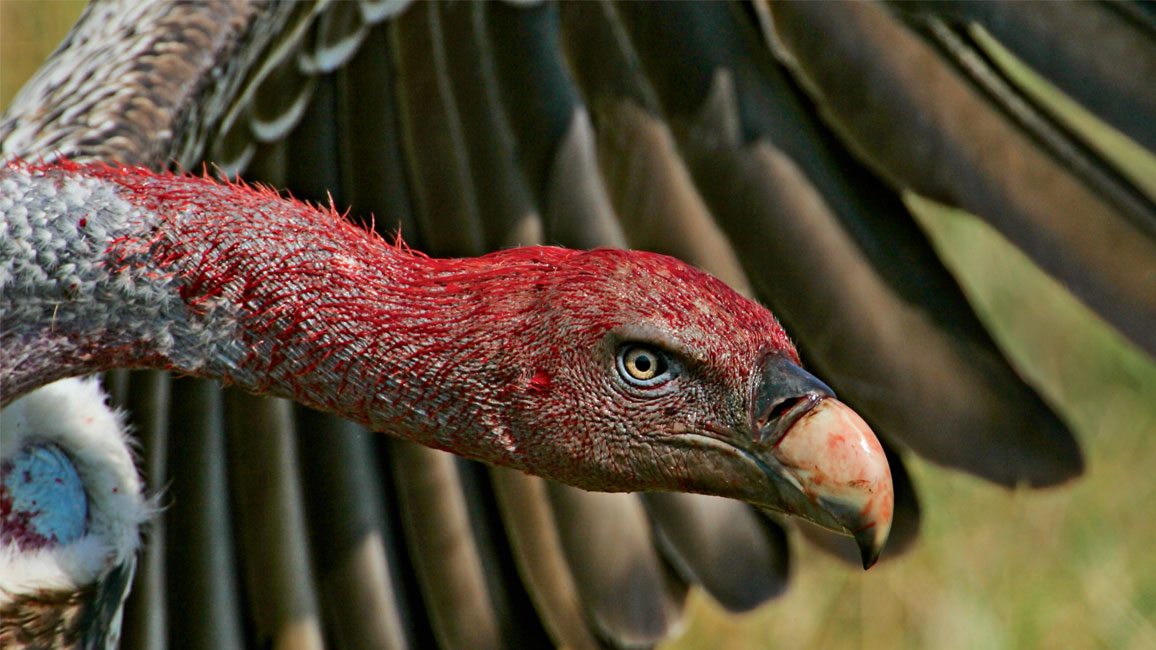
Boning up on Vultures
By Pamela BucklingerGet to know these “garbage cans with wings”!
Looking quickly, you might think this Rüppell’s griffon vulture has a pretty red head. But take a closer look, and—yuck!—that’s blood from its latest feast! Vultures are well known for their choice in meals. Rotten meat, bones, fur. . .nothing is left off their menu. Hungry for more details? Then read on!
Chowing Down
Vultures never mind leftovers. These birds are scavengers (SKAV-en-jurz). That means they usually feed on carcasses, the bodies of dead animals they find. Many creatures would get sick from eating rotten meat. But vultures have special chemicals in their stomachs that kill bacteria in their food. And vultures have bald or lightly feathered heads for a reason: Sometimes they need to stick their faces way down inside a dead animal’s body to reach the last bits of meat. Having fewer feathers means less yucky stuff sticks to the birds’ heads. So being feather-free helps keep them bacteria-free.
A little water doesn’t stop the black vulture above left from feeding on a dead caiman (CAY-men). The caiman’s body provides a landing pad.
It’s dinnertime for three Eurasian griffon vultures picking meat off the bones of a carcass (top photo). The Egyptian vulture (middle photo) has a handy trick to get its favorite treat. It uses a rock to crack open the shell of an ostrich egg. Yum—eggs over easy! The bearded vulture (above right) is eating its usual meal: bones. It can swallow small bones whole. To eat larger ones, it drops them onto rocks to break them apart. This vulture’s table manners have earned it the nickname “bone breaker.”
I THINK I’M GOING TO PUKE
Look up in the sky, and you might see a group of vultures soaring in circles. They can glide on air currents for hours, looking for their next tasty treat. Once they’ve spotted a meal, they’ll quickly land and feast. But sometimes they scarf down so much food that they can’t get back off the ground. In that case, they just barf up some food to lighten their weight and then take off again.
The turkey vulture chick (above left) has fluffy, white feathers on its head now. As it grows, it will lose the feathers and become bald. A turkey vulture (middle photo above) is spreading its wings out to warm up in the sun. Its wingspan can reach an impressive six feet.Up close, the best way to tell a black vulture (top right) from a turkey vulture is that it has a gray head, while a turkey vulture’s head is red.
LOCAL FAVORITES
Three types of vultures live in the United States: the turkey vulture, the black vulture, and the California condor. Both turkey and black vultures are faily common. But the California condor, one of the world’s largest flying birds, nearly went extinct. Lead poisoning was one reason that condors were almost wiped out. When these vultures “cleaned their plates,” they also ate lead fragments from hunters’ bullets that killed the animals they ate. Now there are laws against using lead bullets. People have worked to help condors in other ways, too. And their numbers are growing once again.
VULTURE VIEWING
Start looking out for black or turkey vultures. It’s pretty easy to tell them apart. Black vultures have gray heads and white wingtips. Turkey vultures have read heads and silvery wing edges. When soaring, a black vulture flies with its wings held out straight, while a turkey vulture holds its wings in a V-shape.
As you’re watching vultures circling, think about this: Although the eating habits of these birds might seem disgusting to you, their way of life works for them. And, by eating up dead animals, vultures help prevent the spread of germs that can cause diseases. So even though they eat gross things for their suppers, vultures are actually great cleaner-uppers.



















